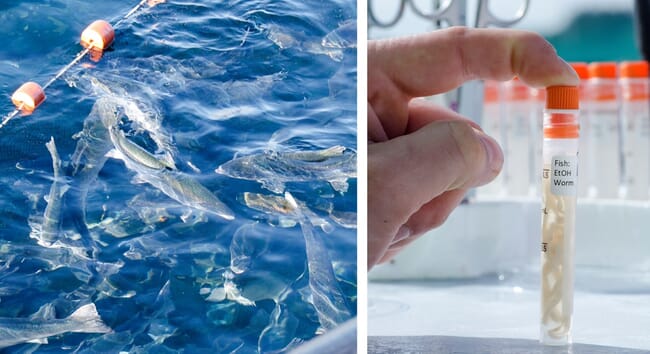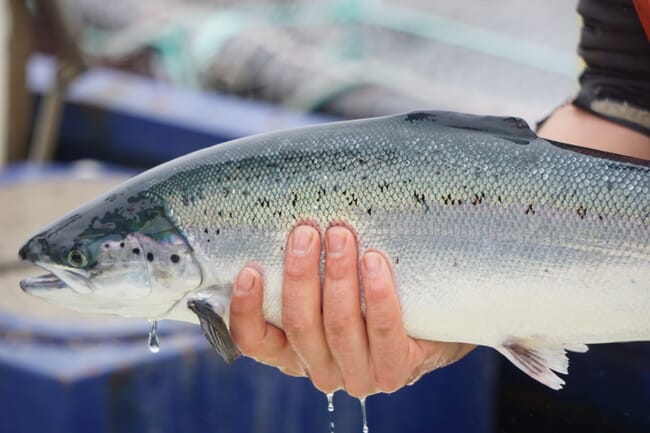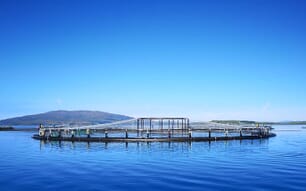
Researchers from the Norwegian University of Science and Technology and the Center for Evolutionary Hologenomics have found and characterised the gut microbiome of tapeworms commonly found in Atlantic Salmon © Martin Neilsen
As more and more research studies find that the gut microbiome has profound effect on its host – from adaptation, gene expression and regulation, immune system maturation, maintenance of the gut mucosal barrier and as protection from pathogens – the role of tapeworms living in the gut microbiome has become a critical point of interest. Previous research in the aquaculture industry has found indications that tapeworms play a central role in key areas of farm-level improvements, namely growth deficiencies, health and fish welfare.
This makes a new study carried out by postdoc Jaelle Brealey from the Norwegian University of Science and Technology and Professor Michael Martin (NTNU), alongside associate professor Morten Limborg and PhD student Jacob Agerbo Rasmussen from the Center for Evolutionary Hologenomics (CEH) and colleagues, compelling. The paper has recently been published in mBio and adds to a small but growing body of evidence for the importance of parasite microbiomes.
Russian doll (matryoshka) holobionts
The study posits that the tapeworms carry their own microbiome and should therefore be considered as a holobiont – a host organism and all its associated microbes – that is functioning within the Atlantic salmon, which is also a holobiont. The interaction is then like a matryoshka doll of holobionts, a finding that has profound implications for how intestinal parasite infections should be considered and tackled in the future.
“Tapeworms could act as a vector, potentially introducing pathogenic microbes to the salmon,” explains Jaelle Brealey, lead author on the study. “It also means that efforts to manipulate the salmon gut microbiome to improve fish health or growth might be confounded by tapeworm-associated microbe interactions with the salmon gut microbiome. Gut microbiome optimisation is an active area of research for the salmon aquaculture industry, and our study suggests that tapeworm infection status is an important factor to account for in such trials.”
Different strains of mycoplasma bacteria
One key observation from the story shows that while bacteria of the Mycoplasma genus have previously been found in abundance in healthy farmed salmon, researchers noted that the tapeworms themselves have a separate strain of Mycoplasma in their microbiome.
“We still don’t know how these two intertwined microbiomes might interact and there are many outstanding questions. For example, are the tapeworm-associated microbes colonising the internal body cavity of the tapeworm, or only its surface? Are they introduced by the tapeworm when it first enters the salmon, or are they already at low abundance in the salmon gut, but preferentially colonise the tapeworm when it’s present? Do the two Mycoplasma strains directly interact or are interactions mediated through the salmon immune system?” asks Jaelle Brealey.
However, sequencing results have indicated that selection of bacteria is happening from both the flatworm and salmon, suggesting a specific interaction between salmonid hosts, tapeworms and Mycoplasma species, providing potential for a coevolutionary relationship. This relationship is an area that Jaelle Brealey hopes will be delved into in the future.
“It would be interesting to sample the other stages of the tapeworm life cycle such as eggs and larvae and its intermediate hosts, for example copepod crustaceans, and compare their microbiomes to the adult tapeworm in the salmon. If the microbe is present at multiple life stages, it suggests that it’s important to tapeworm biology,” she explains.
Deeper understanding could improve the salmon sector
The study thereby suggests an even deeper level of investigation than host-microbiome interactions, one that also considers the host-microbiome interactions of the parasitic tapeworms living in the gut, also called intestinal cestodes, and what impact that can have on the host. Such investigations may have important implications for applied parasitology.

“For example, parasite-associated microbes essential to colonisation, survival or reproduction could be targeted with eg phage therapy, instead of using antiparasitic drugs against the parasite itself. Such an approach could be particularly important in cases where current antiparasitic drugs are unavailable or drug resistance has developed,” explains Jaelle Brealey.
The increased understanding of parasite-microbe evolution and the roles of parasite-associated microbes that this study presents has opened new avenues of research in parasite biology. This may contribute to new prevention and treatment strategies of high medical, veterinary, agricultural and aquacultural significance.




